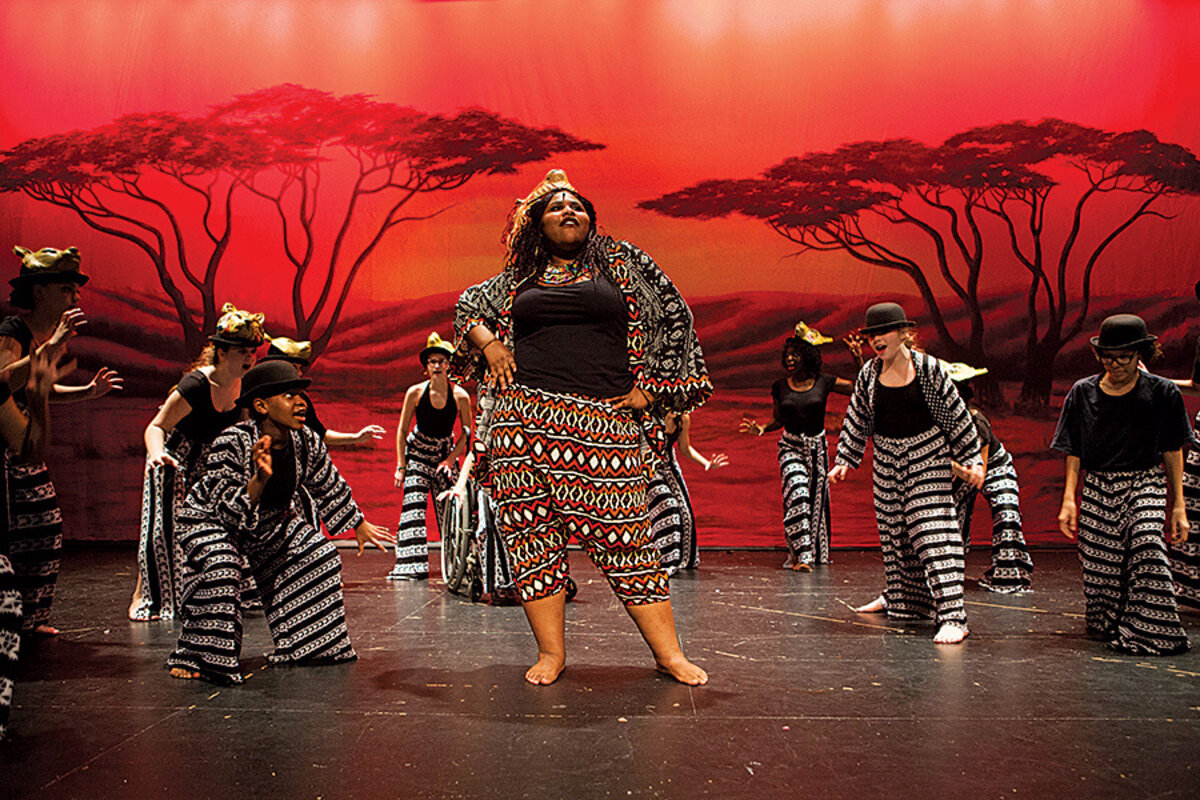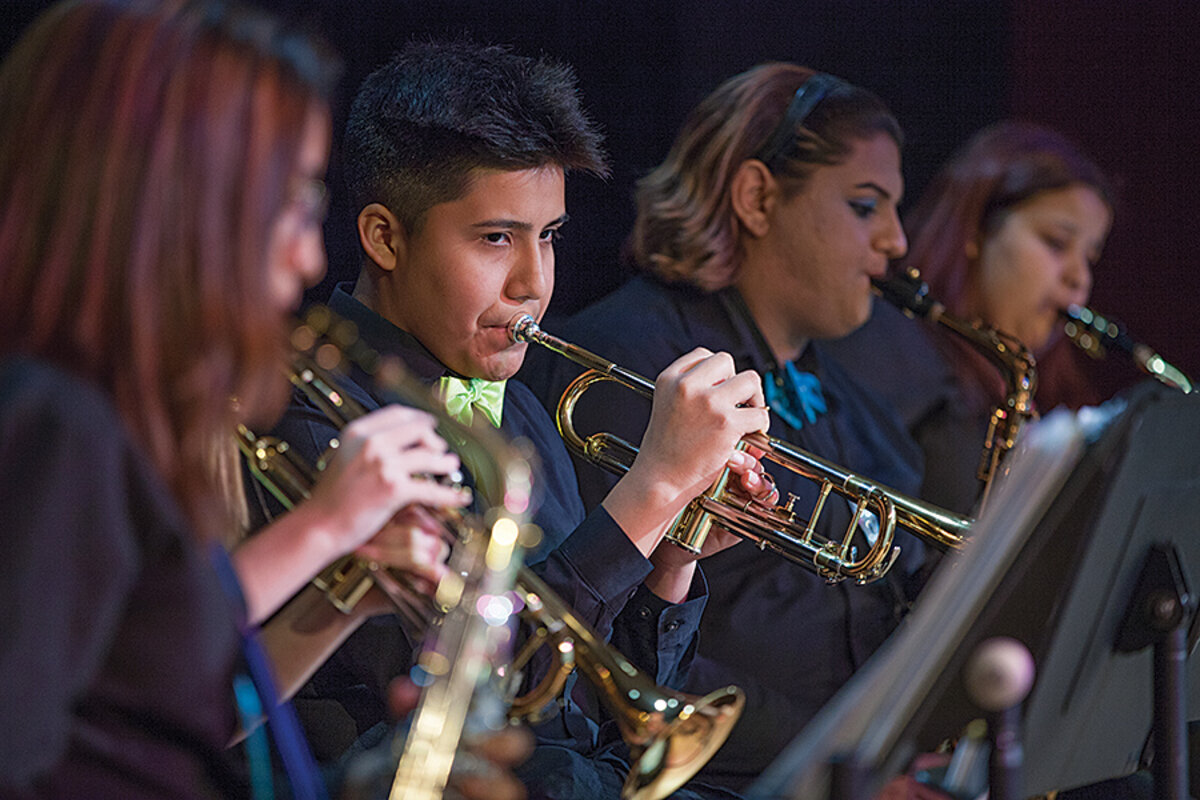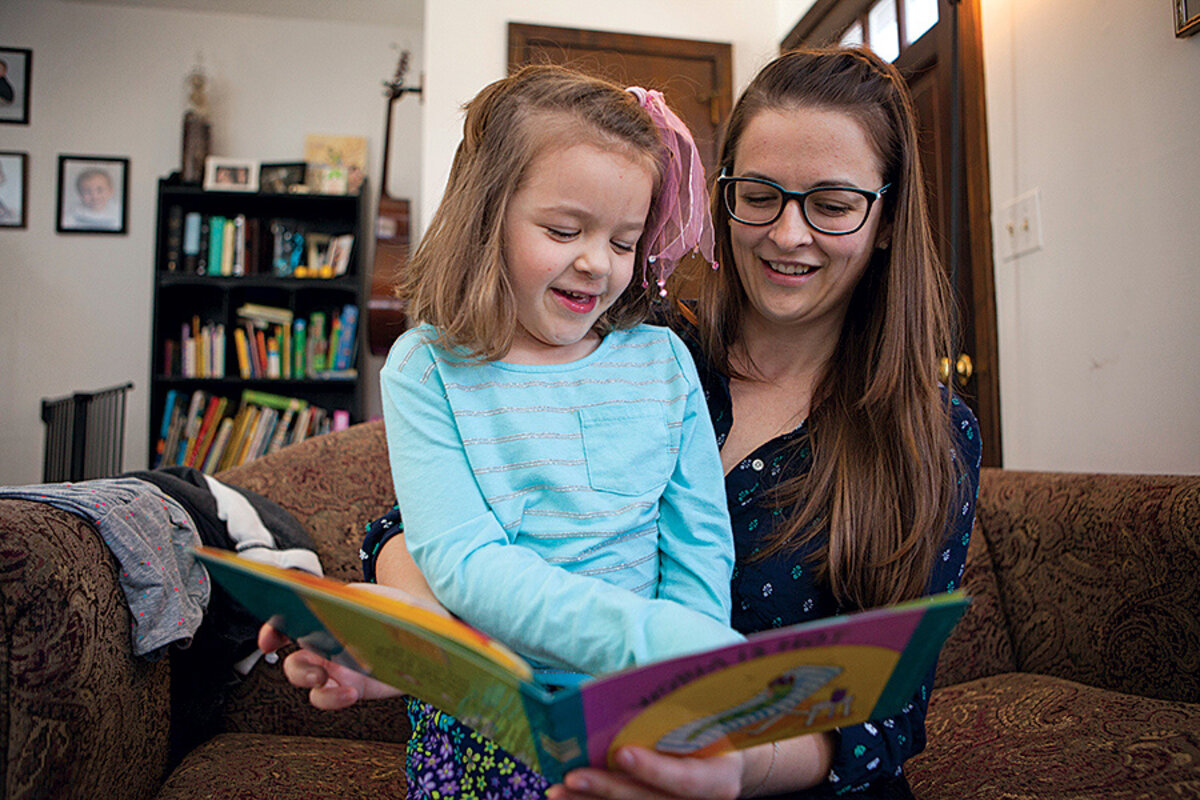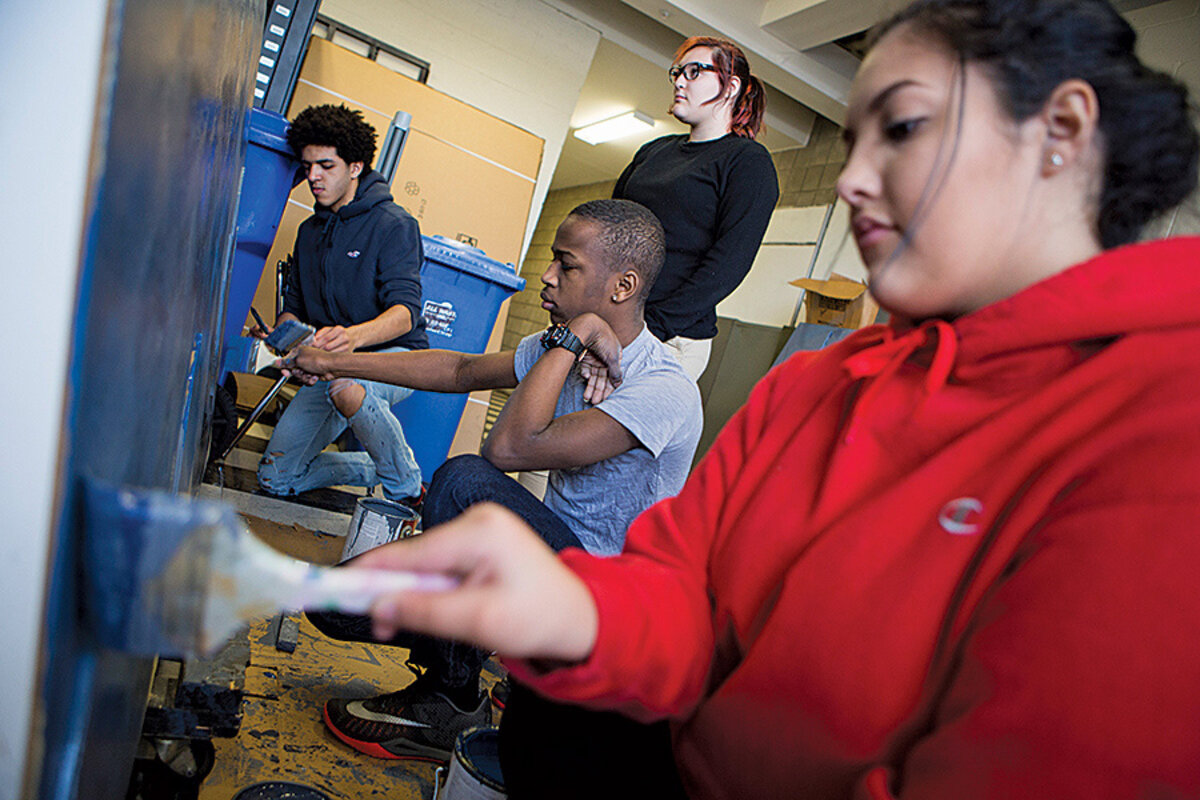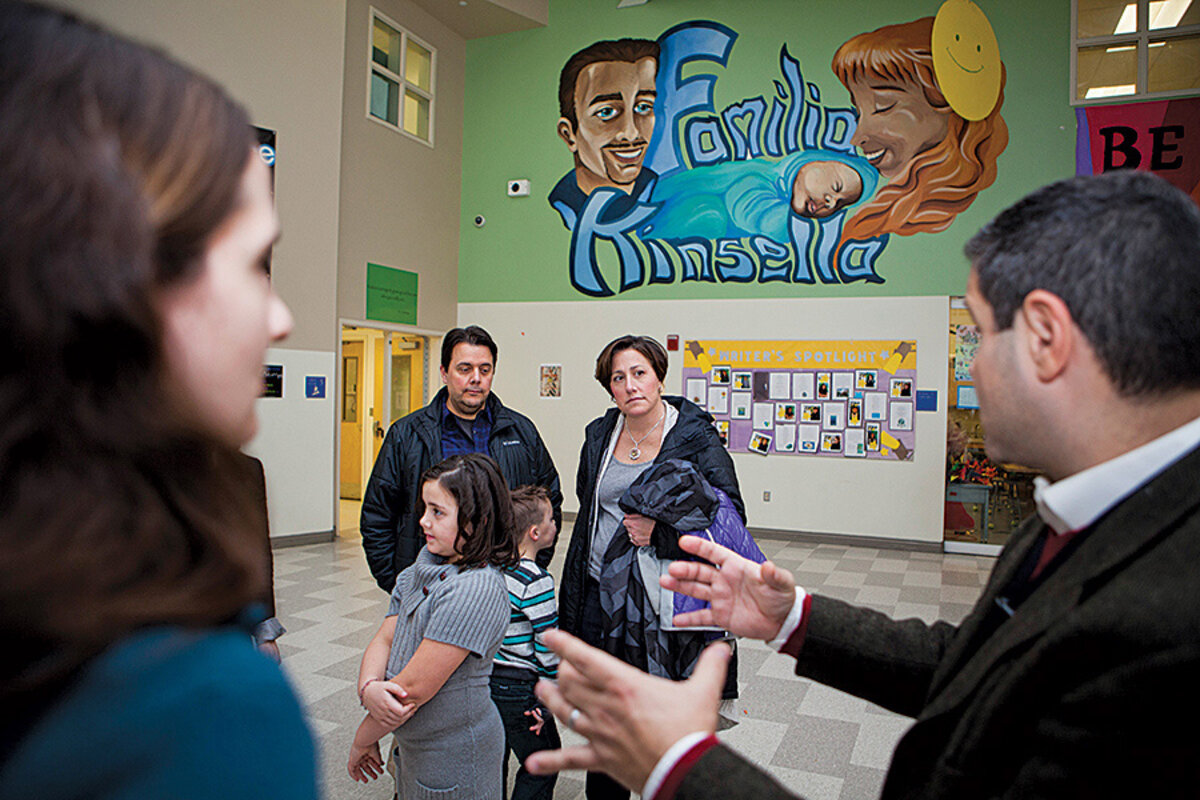Where busing works
Loading...
| HARTFORD, Conn.
Inside the darkened auditorium, a velvet curtain is pulled back to reveal a hand-painted backdrop of a red-hued African savanna. The first wave of dancers skitter across the spot-lit stage, their youthful faces upturned beneath handcrafted animal masks. After four months of rehearsals, “Lion King Jr.,” a version of the celebrated movie and Broadway musical, is bursting to life onstage.
The cast is racially and ethnically mixed: Scar, the conniving uncle, is played by an African-American girl. Zazu, the simpering courtier, is portrayed by a white. The rainbow colors of their costumes – made in-house – seem to reflect the diversity of the exuberant middle-schoolers and the capacity crowd of parents, teachers, and fellow students enjoying the show.
Four rows back sits Stephanie Harris. Her daughter, Tyra, a sixth-grader, plays a gazelle, and Ms. Harris has driven 20 miles from her suburban home to watch her. It’s a journey that Tyra makes daily on a school bus, along with hundreds of other suburban kids who attend R.J. Kinsella Magnet School of Performing Arts, not far from downtown Hartford, Conn.
The emphasis on theater and music was part of the draw, but so, too, was the racial diversity of the student body. “This is the way it’s supposed to be,” says Harris. “This is the way we’re supposed to teach our children – that this is the world they live in and they need to ... make it better with their choices.”
Young Tyra is a small part of one of the most ambitious experiments in voluntary desegregation in the nation.
Two decades after Connecticut’s highest court ruled that confining minority students to nonwhite city schools violated their right to an equal education, Hartford has revamped its educational system to promote diversity in a way that many cities failed to do with mandatory busing programs in the 1970s, ’80s, and ’90s.
Families can choose to apply to magnet schools, attend their neighborhood school, or sign up for a busing program to other districts. The goal is to ease racial isolation, promote excellence, and end the cycle of failure that afflicts poverty-stricken school districts. Today, nearly 10,000 city students, or close to half, attend integrated schools, up from less than 10 percent in 2003.
Hartford is going against the national trend in its quest to integrate its schools. Even as the population of children in the United States grows more diverse – half of all K-12 public students are minorities – segregation by race and ethnicity remains the prevailing practice. The typical white pupil attends a school in which 72 percent of classmates are white and only 8 percent are black. Blacks and Latinos sit in classrooms where the vast majority of students are African-American and Hispanic. Today the states with the most segregated schools are found not in the South but in the North.
Until recently, trying to get a suburban family to send a kid to a public school in Hartford would have been almost impossible. The city is the poorest in Connecticut, a state of extreme wealth and deprivation that cleaves along racial lines and manifests a yawning achievement gap between rich and poor school districts. In 2004, Kinsella ranked last in student achievement in Hartford. Only 7 percent of fourth-graders passed the state’s reading test.
Two years later, Kinsella converted to a magnet school with a specialty in the performing arts. Students from across the city and suburban districts began to enroll. Its classrooms grew more diverse. It improved its test scores and added a high school. Today getting into Kinsella requires applying for a lottery number, and there’s a long waiting list.
Kinsella’s academic transformation and racial mixing are intertwined. It is one reason Hartford has become a test case for how far the nation’s white majority, forecast to become a minority by midcentury, is prepared to buy into a shared vision of integrated education. Visiting a city magnet school last year, John King Jr., then US secretary of Education, praised Hartford’s desegregation program as a “model for the country.” He added: “You are preparing young people for the diverse world that they will inhabit.”
This shift goes beyond schools. At a time of social divisions, rising inequality, and a fraying belief in integration as a political imperative, what happens in cities like Hartford could illuminate the choices that lie ahead for a country still tethered to a white-
dominant identity.
• • •
Growing up in Hartford in the early 1990s, Jamil Ragland knew what segregation meant. In his crime-ridden neighborhood, the young African-American saw only black and Puerto Rican families. But when he got off the school bus in Simsbury after a 40-minute ride, he entered an all-white elementary school where he felt like an intruder. “All the black kids in the school were bused in,” he says.
Hartford’s busing program only served 3 percent of the city’s students, so Jamil was fortunate to get a spot. His younger brother, Khalil, wasn’t so lucky. He attended R.J. Kinsella, as it was then called, where teachers were so short of materials that they had to photocopy textbooks. Khalil’s classroom was a sea of predominantly black and brown faces, the inverse of Jamil’s suburban school.
As Jamil shuttled between these two worlds, a civil rights lawsuit was under way in a city courtroom that would transform how Connecticut educates children like him. The lead plaintiff was Milo Sheff, a 13-year-old African-American who attended an all-minority school. The lawsuit alleged that the state had failed children like Milo by isolating them by race and ethnicity in substandard schools.
Milo told the court that in nine years of public school he had only had one white classmate.
Hartford at the time shared much in common with larger cities, such as Chicago and Philadelphia, where decades of white flight to suburbia had compounded the hardships of its largely African-American and Hispanic residents. To this day, the typical family in Hartford, despite its being the state capital and hub of the lucrative insurance industry, lives on $29,430 a year, less than half the state average.
Since the lawsuit hinged on the deprivations of children of color, Milo became its public face. But the lawyers also brought in a white suburban family to show that school segregation is harmful for the broader community by limiting exposure to diversity.
Civil rights lawyers were trying to enforce desegregation in Hartford while many other cities were retreating from it. In the 1970s, urban areas across the country launched integration initiatives – most notably controversial mandatory busing programs. By the 1980s, however, the desegregation wave had receded. President Ronald Reagan, in a 1984 campaign speech, said busing “takes innocent children out of the neighborhood school and makes them pawns in a social experiment that nobody wants. We’ve found out it failed.”
Conservative judges put limits on how far lawmakers could go in forcing schools to diversify. In the 1990s, even cities with successful busing programs, such as St. Louis and Charlotte, N.C., began to unwind them, saying discrimination had ended.
In Hartford, lawyers zeroed in on a state law that prohibited segregation on the basis of race and promised an equal educational opportunity. What Milo experienced, they argued, was separate – and not equal.
In 1996, Connecticut’s Supreme Court issued its verdict: Racial and ethnic segregation, whether intentional or not, “deprives schoolchildren of a substantially equal educational opportunity and requires the state to take further remedial measures.” But it didn’t order a specific solution, and two years later the lawyers were back in court to contest the state’s fitful response.
By then, Jamil had left Hartford. His family was evicted from public housing after his father, a former US Marine, was busted for dealing drugs, and his mother moved the family to Bloomfield, a racially mixed town outside Hartford.
In 2003, the state reached a settlement with the plaintiffs in the Sheff case. It agreed that Hartford and outlying districts would build and run regional magnet schools open to all via a lottery and expand the existing busing program. The state would foot the bill.
The race to desegregate, by creating schools that parents would want their children to attend, even if in the inner city or far across town, was on.
At the door of a school gymnasium, Megan Goodell shoulders her leather purse and pulls out a printed list. Inside the gym, below the basketball hoops and team pennants, dozens of school officials and parent volunteers hover next to booths hung with slickly produced posters and school logos. All are scanning the room for parents who have set aside a Saturday morning to attend this school fair, parents who are deciding which boxes to tick on Hartford’s regional magnet-school lottery.
Parents like Ms. Goodell.
Her first stop is an elementary school that emphasizes literacy. Goodell asks about transportation for her daughter, Olive, who is 4. The white family lives in the suburbs, and the idea of putting Olive on a bus is a little unnerving. A school official assures her that the buses run reliably to her town, extols the reading program, and gives her a brochure.
Goodell moves on to the next booth, a school with a curriculum based on character development and training in mindfulness. This might suit Olive, who is an anxious girl, she says. “It’s yoga for the mind,” says the principal. Goodell nods and extracts a pen from her purse. “I might put a star next to your school,” she says.
This is what school choice looks like in Hartford. Parents pick from more than 40 magnet schools that offer a dizzying range of specialties in new or refurbished facilities that resemble private academies. There’s a school with its own planetarium, another with a vivarium for raising plants and animals. Kids can study aerospace or sports science. One school has a Montessori program, another an international baccalaureate curriculum.
Every year, families enter a springtime lottery that assigns students to these schools based on their choices and their background. Students who don’t get a magnet slot, or decide not to take one, can revert to their local school. More than 20,000 students applied last year, and 38 percent got a seat. Kids from urban Hartford have a better chance of getting slots than suburbanites, though more than half of the inner-city students didn’t receive an offer.
Had Milo Sheff not sued the state, this expensive ecosystem of magnet schools, in which thousands of Hartford children sit with suburban white kids in state-of-the-art classrooms and labs, would not exist. Between 2003 and 2013, Connecticut spent more than $1.4 billion on magnet school construction or renovation in Greater Hartford and included magnet schools in suburban districts in the program.
The pursuit of racial diversity isn’t obvious at the school fair. It’s there if you look for it, in the smiling faces of the multiracial schoolchildren in the posters. But the emphasis is not on civil rights but on the cornucopia of choices for the white suburban parents that schools need to attract to make integration work. Most Hartford families need little persuading that a magnet school is worth a shot; suburban families can be a harder sell.
For some white parents, exposing their children to classmates from different backgrounds is a selling point. But many are like Goodell – diversity is fine, but it’s not why they’re applying.
In 2015, Hartford surveyed 100 parents about how they made their lottery picks and nearly all ranked a school’s quality and reputation first. For urban families, integration also mattered. Suburbanites didn’t see it as a factor.
Until recently, Goodell had never heard of the Sheff lawsuit. She wasn’t keen on the schools in Manchester, the suburb where she lives with her husband, Olive, and her 2-year-old son, Judah. The local parochial schools were too expensive. A magnet school could be the answer, even if it meant putting Olive on a bus.
“I’m not so concerned about why [magnets] exist. I’m just happy that they do exist because it gives us a better choice than our public schools,” says Goodell. “It’s definitely the best free option. It might be the best option all round.”
She stops at the Kinsella booth to admire the pictures of students onstage. Irene Rietze, a school official with a theatrical air, tells her about their programs and invites her to bring Olive for a tour.
“Does she like the performing arts?” asks Ms. Rietze.
“Well, she’s a performer,” replies Goodell, breaking into laughter.
After two hours at the fair, Goodell walks out with a bag of brochures. She seems settled with the idea of Olive riding a bus and attending an urban school. She has already toured one school and was reassured to see its security cameras and locked doors.
Goodell grew up in a small town in Connecticut where her parents still live. She has qualms about putting Olive in a classroom with children from different cultures and backgrounds, but sees the lottery as a way for families that are committed to a school to make their selection. “They’re being intentional about it,” she says.
• • •
In 2003, Jamil moved to Virginia to attend college, but within a year he’d dropped out and was back in Hartford, working nights in the mailroom at an insurance firm. He enrolled in community college and discovered a passion for history, which eventually led to a bachelor’s program at Trinity College, where he mixed with white kids who joked about spending $600 on a pair of shoes.
Unlike Jamil, these students had breezed through suburban schools and private colleges. They had never been evicted or bused. “It’s a completely different way that they view the world,” he says.
The Sheff lawsuit was designed to help kids like Jamil – black, poor, bright, trapped in low-achieving schools. But the more he saw of the settlement, the less he liked it. Why, he asked, do we need to uproot students of color, instead of fixing their neighborhood schools, and why are we building magnet schools in the suburbs? What is so great about racial integration?
In 2008, he wrote an opinion piece in the Hartford Courant, arguing against “the belief that integrating the school system is the silver bullet to cure Hartford’s education woes.” He noted that white students are the most racially isolated group in the state, yet there is no call to desegregate affluent suburbs.
Jamil was leery of busing. He remembered the stigma of being the black kid in class. He thought it important to support local schools, to resist the idea that minorities can’t succeed in their own community.
In 2013, those ideals were tested when his son, Gabriel, turned 4. Jamil had tutored kids at a chaotic neighborhood school that Gabriel was later assigned to. So he entered him in two different lotteries. The one that came up was a busing slot to a suburban school. “I didn’t want to put him on the bus because I’d been on that bus,” says Jamil. But, after two days, he caved.
Busing arouses strong feelings on all sides, even when a program is voluntary. Hartford’s initiative, encompassing both urban and suburban districts, has struggled to scale up because suburban schools aren’t compelled to accept students. Financial incentives and state persuasion have increased the number of slots that schools in 27 suburban districts offer to 2,157. But administrators say that is still far short of the number of urban students available to fill them.
Even districts with aging populations that could benefit from bused-in students are often loath to accept more. Glastonbury, a wealthy suburb, only offers five kindergarten slots per year. Yet its school board recently voted to close Eastbury Elementary School in 2018, citing a shrinking school-age population.
Michele Mudrick, whose daughter attends Eastbury, repeatedly asked the board about its participation in busing and was told it wasn’t the solution. Other parents were also cool to the idea, she says, preferring to wait to see if more families move to the area rather than bringing in outside students.
“We tell our children to share their toys and other things,” says Ms. Mudrick, a lobbyist. “But we’re not sharing our schools.”
Leslie Archambault, another parent who opposed the closure, says the busing program isn’t popular in Glastonbury, where household incomes average more than $100,000. “It’s not well received, or maybe just not supported,” she says. “People feel like they’ve scraped and worked really hard to move their children here. Using the [busing] program will change that dynamic.”
While the lack of openness of some suburban schools represents one challenge to the program, so do changing demographics. The Sheff settlement was premised on the idea that schools with students from urban and suburban neighborhoods would yield racially mixed classes. But as suburbs become less white – more blacks and Hispanics nationwide now live in suburbs than in cities – the colorblind formula used to select students in the lottery isn’t creating as much diversity.
Students being bused across town can find the transitions difficult as well. For two years, Jamil’s son, Gabriel, rode the bus to a majority-white school in Ellington, 25 miles away. Jamil worried that he would be ostracized there and felt powerless to step in. He didn’t have a car and money was tight. One day a classmate told Gabriel at recess that he didn’t want to play with a black boy.
“That’s the experience of a first-grader in 2013,” says Jamil. “People don’t think this kind of stuff happens. But it does, all the time.”
Gabriel has since transferred to another school where he’s happier. Jamil, now a registrar at Wesleyan University, has softened his views on the program, seeing its benefits as well as limitations. “It’s not perfect,” he says. “But it’s the best approach we have right now.”
Hartford’s initiative has, in fact, tallied some successes. It has already improved the academic achievements of black and Hispanic students. A 2011 study found that attending a magnet high school boosted math and reading scores for these students, compared with those of students who weren’t selected in the lottery.
Similar research at the national level has found merit in busing programs. A long-term study of black adults who as children were subject to court-ordered desegregation programs reported significant gains, including higher earnings and better health, compared with blacks who didn’t attend integrated schools. The 2015 study by the University of California, Berkeley found no negative effect on white children affected by the programs.
Far harder to weigh, but perhaps just as salient, is the benefit of cross-cultural relationships that flourish in public schools with diverse student bodies: the friendships that would not have happened, the prejudices that proximity tempered.
This transformation came too late for Milo Sheff. He left his high school and became a rapper, chef, and entrepreneur. One of his sons now attends a city magnet school.
His mother, Elizabeth Horton Sheff, a retired city councilor, remains vigilant about the case, which is still subject to court supervision. She wants to see access for all Hartford’s students who wish to go to quality integrated schools, whether magnet schools or suburban district schools, and believes that the entire classroom, not just minority kids, benefits from diversity.
“If you’re with everyone who looks like you and talks like you and dresses like you that’s all you’re going to know,” she says. “If you’re in a room and there’s people with different experiences and different viewpoints, that strengthens your own ability to critically think, make up your own mind, and explore new worlds. That’s the best thing you can do for a child.”






